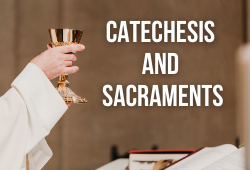Textbooks
Textbooks are first and foremost tools within the catechetical process. As tools, they should never be confused with the essential elements of the formation process. The Holy Spirit is the most essential reality of any formation process done in the name of the Church.Messiah Jesus has promised that where two or three are gathered in his name, we are assured the Spirit is present. The Holy Spirit is both the bringer and the animator of faith. The person of the catechist is the next most essential element in the process of formation.
The catechist, as a representative of the Church, is a living sacrament of the presence of Christ. This living witness to the Good News of God is in many ways both the teacher and the lesson. The Curriculum is the next essential element in this lineage. The curriculum stands as a stable statement of the important issues which should be addressed, and in what order their presentation makes the most sense.
Textbooks, audio-visuals and other resources are the tools that the catechist has at her/his disposal to make the curriculum come alive. Textbooks are important resources and need to closely match the curriculum, be of a high quality and support the work of the catechist.
Publishers' Contact Information: Flyer containing R.E. Material Publishers
General Diocesan Policies for all Religion Textbooks:
- Enjoy an Imprimatur and Nihil Obstat from the competent ecclesiastical authority
- Are on the USCCB Subcommittee of the Catechism’s “Conformity List”
- Follow a “spiral curriculum” so that important matters of faith would be covered over a number of years, with increasing depth and detail in successive years
- Be complemented by extensive on-line resources for the student, family and teacher
- Be “consumable,” i.e. designed to prompt the student’s personal use
Approved Texts: Elementary and Junior High Textbooks (authorized Feb. 22, 2013)

Required Text: Senior High:
Specific Recommendation: Junior High
7th grade: Mystery of God and Morality (from RCL)
8th grade: Jesus in the New Testament and Church and Sacraments (from RCL)
Also available from the Department of Religious Education is a program entitled “Teen Disciples” which blends the required texts into a comprehensive model of youth ministry.
The United States Bishops’ Framework for High School Catechesis will be taught using the following resources:The National Catechetical Directory offers the following comprehensive list of criteria for textbooks:
Center For Ministry Development – specific lessons on their subscription website have been selected as the primary tool to teach the Framework. For more details and specific lessons please see the Curriculum section of this web page. “Catholic Faith Handbook for Youth” – St. Mary’s Press is to be given to each student.
Present the authentic message of Christ and his Church, adapted to the capacity of the learners and in language that can be understood by them.
Be faithful to the Sacred Scripture.
Highlight the essential truths of the faith, giving proper emphasis to particular truths in accord with their importance within the hierarchy of truths.
Be in conformity with the Catechism of the Catholic Church.
Be approved by the local Bishop.
Give to those who use them a better knowledge of the mysteries of Christ.
Promote a true conversion to Jesus Christ.
Inspire and encourage those who use them to live the Christian life more faithfully.
Be culturally appropriate and reflect the real-life situations of those who use them.
Promote charity, appreciation, and respect for persons of all racial, ethnic, social, and religious backgrounds.
Present other ecclesial communities and religions accurately.
Employ a variety of sound catechetical methodologies based on the results of responsible catechetical research.
Include appropriate examples of Christian prayer and opportunities for liturgical experiences and incorporate the use of Sacred Scripture as a text for study along with other catechetical textbooks.
Offer short passages of Sacred Scripture that can easily be learned by heart.
Contain opportunities to review and measure progress in learning.
Be visually attractive, engage the students, and incorporate a variety of examples of Christian art.
Include graphics that represent the various regional, cultural, economic, and religious characteristics of the people who will be using them.
— National Catechetical Directory, Section 68, A

